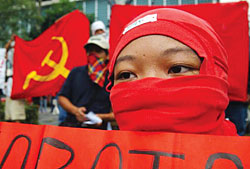 |
As the world\'s longest-running Maoist insurgency enters its 40th year, the low-intensity conflict in the Philippines offers several lessons for Nepal about why a peace process can\'t be left half-finished.
Nearly 50,000 people have been killed since 1968 in a war that pits the Maoist New People\'s Army (NPA) against the Philippine Army. It has been 21 years since the first peace talks, but war and peace have gone on in parallel since.
The Communist Party of the Philippines is following a two-track policy of having a political front represented in Congress while keeping a 7,000-strong armed wing to fight the war. The NPA is active in 69 of the country\'s 81 provinces and says it is now \'in the middle of the strategic defensive phase\'.
The army makes little distinction between the political and armed wings of the communists and has arrested senior NPA leaders, including central committee member Elizabeth Principe in Manila this week.
The last round of peace talks collapsed four years ago, and the government has refused to abide by immunity guarantees for its negotiators and has killed nearly 1,000 NPA 'supporters' since 2001. The government campaign aims to destroy the insurgents by 2010, but a secret army document recently revealed that target was unlikely to be met.
"There is war fatigue, and Filipinos are increasingly turning against violence," says analyst Miriam Ferrer. However, the army appears to think it can break the back of the NPA with recent intelligence breakthroughs.
NPA guerrillas, who in the past were politically well indoctrinated in the Maoist mass line, have been accused of indulging in criminal activities. Just as in Nepal, there are frequent reports of extortion by the NPA.
Satur Ocampo, veteran communist leader and member of the Philippine Congress from the Bayan Muna party, says: "The NPA not only wants to achieve military objectives but even more importantly pursue political goals."
His words have a familiar ring when he says: "Revolutionary taxation is not extortion, it is implemented to finance socio-economic programs for the good of the people."
The army's response of not distinguishing between political and military cadre has exposed it to international criticism of extra-judicial killings and disappearances.
"It\'s got to a point where just being labelled communist is enough for a person to be branded and killed," says Ferrer. With a strong anti-communist, conservative government and a rebel force determined to wage both a military and political struggle, the Philippine insurgency looks set to drag on even though neither side sees an outright victory.
Nepal's difference from the Philippines is that our Maoists have fielded the YCL to strongarm opponents, while the PLA is in UN-monitored cantonments and there is an effective ceasefire.
While no two situations are alike, the Philippine case study shows that if the ceasefire does break down, Nepal's Maoists could theoretically fall back on a war-with-peace strategy.
The longer the political deadlock and transition drags on, the greater is this possibility.


